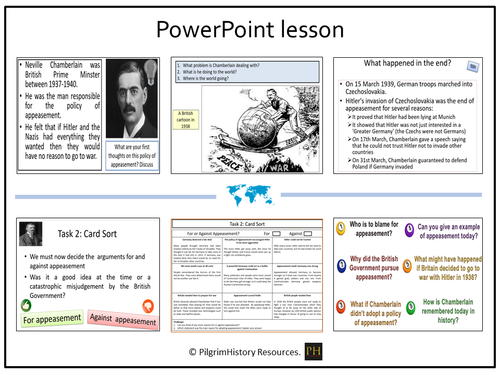


World War II
The aim of this lesson is to question Britain’s policy of appeasement in the 1930’s, but also defend the decision Chamberlain took.
Students have to make up their own minds through a variety of learning tasks which include gathering evidence from video footage of the time, completing a card sort activity, creating causational chains and analysing sources from the time.
Some higher order questions at the end are aimed at getting them to think and challenge the perceptions they have made about appeasement.
This lesson is ideal as preparation for GCSE if you are embedding source skills or teaching the interwar years or WWII at Key stage 4.
It is enquiry based with a key question using a lightbulb posed at the start of the lesson and revisited at the end to show the progress of learning.
The resource includes retrieval practice activities, suggested teaching strategies and differentiated materials and comes in Powerpoint format if there is a wish to adapt and change.
Get this resource as part of a bundle and save up to 30%
A bundle is a package of resources grouped together to teach a particular topic, or a series of lessons, in one place.
World War 2 Bundle
This bundle follows the Key Stage 3 National Curriculum - challenges for Britain, Europe and the wider world, 1901 to the present day with a focus on the conflicts of the Second World War. The aims of this bundle are to know and understand significant aspects of World War II on a global scale and how Britain has influenced and been influenced by this conflict. In the first 12 lessons, students will learn and understand key historical skills throughout such as continuity and change in the role and use of propaganda in World War II, the causes and consequences of the policy of appeasement, breaking the Enigma Code or the evacuation of children, the similarities and differences of life on the Home Front, the significance of Winston Churchill and VE Day and interpretations about whether there really was a Blitz spirit. In lessons 13 to 23 students will learn and understand key historical skills throughout such as change and continuity in the types of warfare used, the causes and consequences of the evacuation of Dunkirk and the similarities and differences of Hitler’s invasion of Russia as compared to Napoleon. They will also learn about the significance of the dropping of the atomic bombs on Japan, refugees in World War 2 as well as interpretations as to whether Sir Arthur ‘Bomber’ Harris should be considered a war hero or not. I have created and used these lessons to challenge and engage students, but also to show how much fun learning about this part of history really is. The lessons are as follows: L1 Causes of World War II L2 Appeasement L3 Winston Churchill L4 The Home Front - preparations L5 The Home Front - propaganda L6 The Home Front - rationing L7 The Home Front - women (free lesson) L8 Evacuation of children L9 The Blitz L10 The Enigma Code L11 Prisoners of war (free lesson) L12 VE Day L13 Overview of World War 2 (free lesson) L14 Invasion of Poland L15 Evacuation of Dunkirk L16 The Battle of Britain (free lesson) L17 The Battle of the Atlantic L18 Hitler's invasion of the Soviet Union L19 Sir Arthur Bomber Harris L20 D-Day landings L21 The attack of Pearl Harbour L22 Dropping the of Atomic Bombs on Japan L23 Refugees in World War 2 Unfortunately due to TES restricting bundles to 20 resources, the free lessons of 7, 11, and 16 will need to be downloaded separately. This bundle includes retrieval practice activities, suggested teaching strategies and differentiated materials. All lessons come in PowerPoint format if there is a wish to adapt and change.
World War 2 Home Front Bundle
This bundle follows the Key Stage 3 National Curriculum - challenges for Britain, Europe and the wider world 1901 to the present day with a focus on the Second World War and the wartime leadership of Winston Churchill. The aims of this bundle are to know and understand how people’s lives in Britain were affected by World War 2 under the guidance of Winston Churchill. I have created, readapted and used these lessons to challenge and engage students, but also to show how much fun learning about this part of history really is. Students will learn and understand key historical skills throughout such as continuity and change in the role and use of propaganda in World War II, the causes and consequences of the policy of appeasement, breaking the Enigma Code or the evacuation of children, the similarities and differences of life on the Home Front, the significance of Winston Churchill and interpretations about whether there really was a Blitz spirit. The lessons are as follows: L1 Adolf Hitler L2 Causes of World War II L3 Appeasement L4 Winston Churchill L5 The Home Front - preparations L6 The Home Front - propaganda L7 The Home Front - rationing L8 The Home Front - women (free lesson) L9 Evacuation of children L10 The Blitz L11 The Enigma Code L12 Prisoners of war (free lesson) L13 Occupation of the Channel Islands This bundle includes retrieval practice activities, suggested teaching strategies and differentiated materials. All lessons come in Powerpoint format if there is a wish to adapt and change. I have also included two free lessons in the bundle to give an idea of what is being offered. I would also strongly recommend you assess students on this unit of study based on GCSE style questions from your chosen exam board.
Something went wrong, please try again later.
This resource hasn't been reviewed yet
To ensure quality for our reviews, only customers who have purchased this resource can review it
Report this resourceto let us know if it violates our terms and conditions.
Our customer service team will review your report and will be in touch.